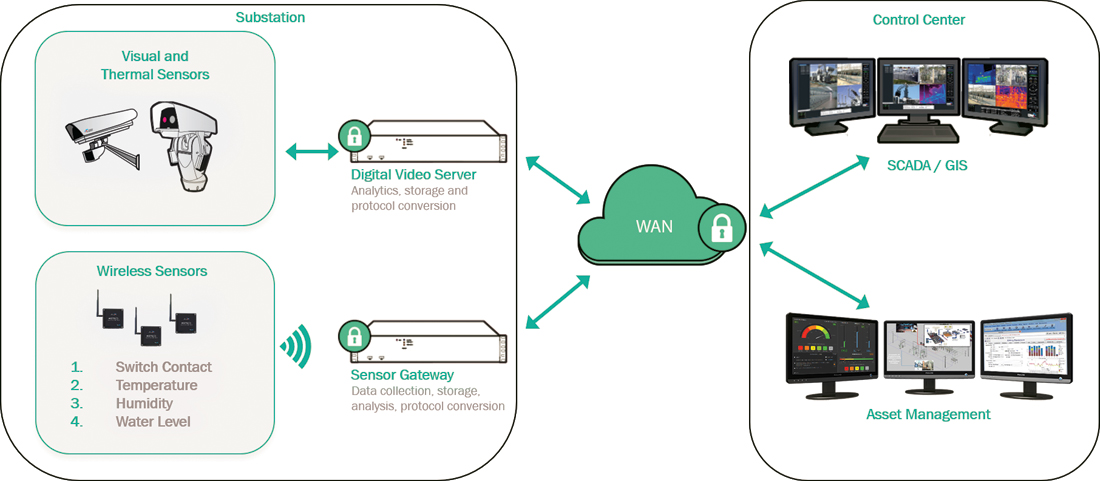Overview
A growing trend in the electric power utility industry is the automated monitoring of remote sites and assets. An electric utility’s assets must be maintained and repaired on a continuous basis to prevent equipment failures and outages and to keep the system operating safely. With the challenge of keeping costs under control and service reliability high, knowing how to prioritize maintenance and repairs to provide the most efficient and cost-effective results is a huge benefit. The development of both sensor technology and communications networks is now providing the means to deploy solutions that can track the health of assets and plan when maintenance should be scheduled to prevent failures. To prevent the utility from being overloaded with the wealth of data from the field, there are also applications available to view the data in real-time and process it to determine health scores and predict when and how failures might occur. Sensor technology can also allow the utility to perform remote inspections to make more efficient use of man and machine hours.
Sensors Provide a Long-Term View and an Immediate Status Real-time monitoring gives operators a live dashboard view of the state of their assets. The automation part provides alarms so even if the operator isn’t watching the dashboard they will be notified that something needs their attention. The operator sets the threshold parameters for the alarm analytics, allowing them to be in control of the system and tune it for their particular situation. The alarm level could depend on specifications from the equipment manufacturer, but it may take into consideration other situations, such as weather conditions and load. The dashboard allows operators the ability to drill down to get more details on what caused the alarm, so they have the data on hand to make informed decisions. Not only can the asset data be presented and monitored in real-time, but it can be stored in a historical database that can be used in predictive analytics to plan and prioritize maintenance, repair or replacement activities. As the sensors are reading information from the assets, the data is not only being presented in real-time but also digitized and stored so it can be used in multiple applications, such as in the calculation of an asset health index. The health index score helps in asset management to track the condition of assets and to determine if any actions are needed to maintain, repair or replace equipment.
Remote Inspections
It has long been thought that the only purpose for video cameras at a substation was to provide physical security at the site. Operators soon discovered that having cameras allowed them to do inspections without having to send field technicians to the site. While the camera system provided automated security through motion detection and perimeter violation, operators could also take control of pan, tilt, zoom, (PTZ), cameras to inspect transformers, switches, etc. The cameras provide real-time situational awareness, allowing operators to diagnose problems without having to dispatch a crew to the site and also ensured safety procedures were being followed when they were on site.
One of the biggest expenses that utilities have is rolling a truck to a site; whether it’s for maintenance at a remote site, or emergency repair or replacement, truck rolls take man-hours away from resources and these can be significantly reduced with the tools that are now available.
Modern communication networks can connect operators to sensors at remote sites; inspections can be done from the control center, allowing them to see the condition of the assets in real-time. Visual inspections can be done using cameras at the site that allow operators to pan and zoom into all areas of the site to inspect equipment, physical conditions and depending on the placement can even read gauges and equipment nameplates. Thermal cameras installed at the remote site can similarly allow a thermographer to do remote inspections. Most utilities are familiar with infrared cameras and will send thermographers to the site to do periodic inspections. Thermal imaging is a useful technology that can uncover many problems; in many issues, heat is a by-product of problem. Issues such as poor connection, failing insulation, load imbalances and partial discharge to name a few, all will produce excessive heat as result of a failing condition that can be detected with the use of thermal imaging camera. Although the technology has been in use for many years, advancements in the field now make the use of the technology even more useful and accessible. The thermal cameras can be programmed to rotate and automatically monitor several pieces of equipment and measure temperatures 24/7. This is an automated, non-invasive technique since it can monitor equipment and points without physical attachment and while the system is powered and under load. It can prevent or at least reduce the number of times the utility must schedule an outage to perform tests and diagnostics on the system. It gives the thermographer more information about the site under different load and weather conditions while saving trips to the site.
Added Safety
The added benefits of remote visualization of a site are the safety aspects. Remote inspections mean the work crews don’t need to enter hazardous work areas as frequently and be exposed to the dangers of high voltage environments. When crews do have to enter the site, having remote visualization can ensure that the proper safety procedures are being followed. Knowing that the site is being monitored can change the behaviour of work crews and ensure that they are not taking procedural shortcuts. Remote inspections can ensure that the physical security elements such as fences and gates are in place and in good condition to deter the public from entering the site.
Condition-Based Maintenance
Companies that practice time-based maintenance realize that often, they are inspecting and maintaining equipment that is in perfectly fine working order. They may spend many miles and hours of man and machine time for a paperwork exercise. Many companies realize that a more efficient means of maintaining a site and equipment is to use Condition-based Maintenance, (CBM). Usually, significant upfront investment is required to install the asset monitoring system before CBM can be employed; however, payback can be realized in various ways. Using CBM, sensors monitor various parts of the equipment under normal operating conditions that let the operator know if the equipment is working correctly. The data collected from sensors is represented in real-time and can also be stored in a database for further analysis. This is important because it can show how the operating characteristics are changing over time. As an example, the transformer and peripherals may be working well within operating limits, but sensors may show that partial discharge around the bushings is present and is actually increasing. This may also be causing a temperature increase and acceleration of the condition. The data from the sensors can be input into an asset health monitoring application to generate a health index and a prediction when a failure may occur. Based on this information the utility will know how long it has to perform maintenance on the transformer/bushings before a failure. If multiple assets from multiple sites are all logged into the CBM system, then the prioritized list of maintenance activities can be generated resulting in a more efficient deployment of personnel and maintenance equipment.
Preventing Outages
There has been a long-standing interest in CBM and the supporting technology to deliver it in a cost-effective means is making it more accessible. With the maturing and coming together of technologies such as edge processing, cloud computing, the Internet of Things and predictive analytics, there are now ways and means to gather and process information in very fine detail that can help utilities predict when failures will occur, so repairs and maintenance can be carried out. Performing maintenance in a timely manner can not only prevent the loss of an expensive asset but also prevent outages that affect industrial customers and the public that result in cascading economic losses.
Calculating the Return on Investment
While utility companies may realize the benefits that remote visualization of sites and assets can bring in terms of maintaining the uptime of their service area, they may find it difficult to justify the cost of the system. The value of the information that automated sensor technology brings goes beyond convenience to operators and engineers and affects the company’s bottom line in different ways, like capital spending, as well as operations and maintenance. It may seem that remote monitoring is like investing in insurance, buying something upfront in hopes of preventing future losses in other areas, but it doesn’t take long to calculate the return on remote asset monitoring. The investment can be amortized over the expected life of the monitoring equipment and is factored against the potential expenses saved over the same amount of time.
Some of the saved expenses:
Reduced truck rolls and man-hours for:
- Visual and thermographic inspections
- Time-based maintenance procedures
- Emergency repairs that could have been prevented
- Loss or damage to assets that could have been prevented by early detection of faults
- Loss of revenue and penalties due to outages that could have been prevented by early detection of faults
Summary
Sensors are continuously evolving; becoming more sophisticated and providing more and more data that is available all the time and that can be gathered remotely. No longer is it required to dispatch crews to check on things at remote sites when the technology exists to perform automated monitoring. The communication technology that enables the Industrial Internet of Things, (IIOT), is also evolving, allowing sensors to be online all the time and to be constantly sending that data. It is becoming more common for remote substations to be connected with high-speed fibre links to monitor and control substations and connect them to SCADA/GIS and asset management applications. It will become more common for devices such as switches, reclosers and arrestors to be smarter and online all the time. With the growing number of sensors in the field, utilities are having to deal with “big data”; having more information available on hand than they have resources to review and analyze. At the same time, the applications and services are also improving to process the data and filter it to provide simpler and more valuable conclusions. Data can not only be viewed in real-time to provide online status of the grid down to the asset level, it can be stored and processed to provide health indices and predictive analytics to schedule maintenance activities. While the amount of data and the evolving technology to gather and process it may seem overwhelming, it will all eventually lead to a more efficient and reliable grid.
 Richard Harada has more than 20 years of experience in industrial networking communications and applications. Prior to joining Systems with Intelligence, Harada worked at RuggedCom and Siemens Canada, where he focused on product management and business development for industrial communications in the electric power market. Harada is an electronic engineering technologist and has a Bachelor of Science degree in computer science from York University in Toronto.
Richard Harada has more than 20 years of experience in industrial networking communications and applications. Prior to joining Systems with Intelligence, Harada worked at RuggedCom and Siemens Canada, where he focused on product management and business development for industrial communications in the electric power market. Harada is an electronic engineering technologist and has a Bachelor of Science degree in computer science from York University in Toronto.







